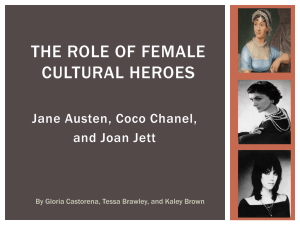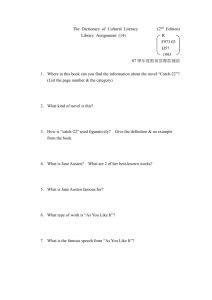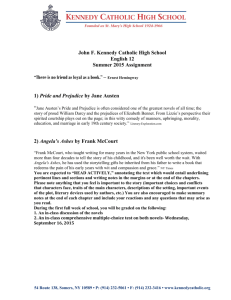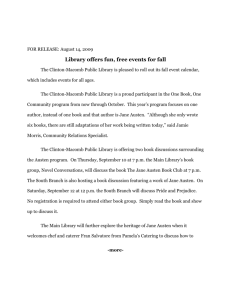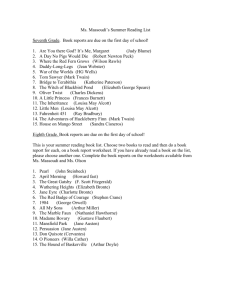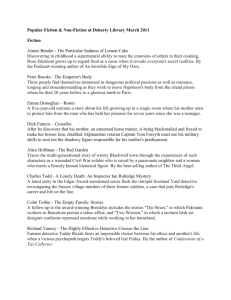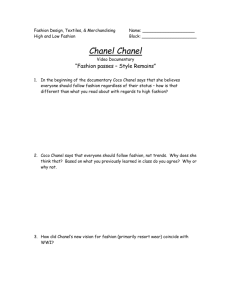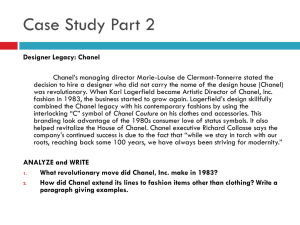Group Paper - Tessa Brawley
advertisement
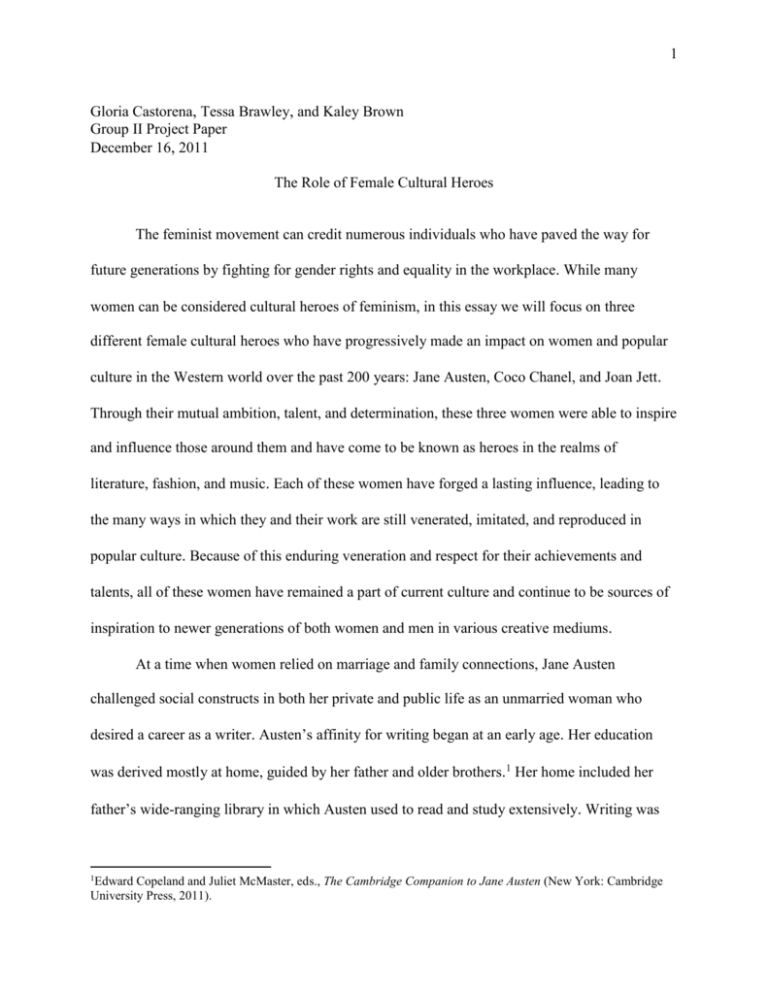
1 Gloria Castorena, Tessa Brawley, and Kaley Brown Group II Project Paper December 16, 2011 The Role of Female Cultural Heroes The feminist movement can credit numerous individuals who have paved the way for future generations by fighting for gender rights and equality in the workplace. While many women can be considered cultural heroes of feminism, in this essay we will focus on three different female cultural heroes who have progressively made an impact on women and popular culture in the Western world over the past 200 years: Jane Austen, Coco Chanel, and Joan Jett. Through their mutual ambition, talent, and determination, these three women were able to inspire and influence those around them and have come to be known as heroes in the realms of literature, fashion, and music. Each of these women have forged a lasting influence, leading to the many ways in which they and their work are still venerated, imitated, and reproduced in popular culture. Because of this enduring veneration and respect for their achievements and talents, all of these women have remained a part of current culture and continue to be sources of inspiration to newer generations of both women and men in various creative mediums. At a time when women relied on marriage and family connections, Jane Austen challenged social constructs in both her private and public life as an unmarried woman who desired a career as a writer. Austen’s affinity for writing began at an early age. Her education was derived mostly at home, guided by her father and older brothers.1 Her home included her father’s wide-ranging library in which Austen used to read and study extensively. Writing was Edward Copeland and Juliet McMaster, eds., The Cambridge Companion to Jane Austen (New York: Cambridge University Press, 2011). 1 2 the preferred form of entertainment for the Austen family. As a girl, the future writer delighted the Austen family by writing and performing short stories.2 By Jane’s early twenties, she started writing First Impressions, now known as Pride and Prejudice, and Elinor and Marianne, which later adopted the title of Sense and Sensibility. Austen’s novels were first rejected and unread by publishers knowing the works were written by a female author.3 Sense and Sensibility was the first novel of Austen’s to be published in 1811. Given the cultural context, Austen stood out against women of her age and time. The presence of many social obstacles to women’s writing could threaten her reputation as well as her social position. Literature had become firmly prominent in society, and authorship provided fame and publicity, therefore a lady in the public eye was thought to loose one’s femininity.4 Austen’s contemporaries such as Sarah Fielding and Ann Radcliffe chose to publish their work anonymously and only chose to include their names once their excellent reputations were well established.5 Four out of six of Jane Austen’s novels were published during her lifetime, and two later by her brother Henry Austen. Although Austen received little fame during her lifetime, her works have since been revived and cherished as ageless classics. The romantic period captured by Austen with simple characters is now the inspiration for several blockbuster plots and film adaptations of her work, hoping to recreate the drama ever present in her novels. Clueless and Bridget Jones’s Diary are among several popular films that have Austenesque storylines. As a woman who defied societal conforms, many women and men seek to identify with Jane Austen in modern cultural concerns. Copeland and McMaster, The Cambridge Companion to Jane Austen, 2011. Ibid. 4 Deborah Kaplan, Jane Austen Among Women (London: John Hopkins University Press, 1992). 5 Copeland and McMaster. The Cambridge Companion to Jane Austen, 2011. 2 3 3 The phrase, “What would Jane Austen do?”—coined by the self-proclaimed “Janites,” or followers of the author’s texts—has now become the inspiration for several products featuring the phrase. As one of the first women to bring a woman’s perspective to the literary world, Jane Austen has influenced generations of authors since she began writing in the late 1700s. Since the publication of her novels, sequels, prequels, and modern adaptations have helped to keep Jane Austen relevant and a beloved female author in popular culture. Novels such as Pride and Prejudice and Zombies attempt to revive the story of Pride and Prejudice in the setting of a zombie apocalypse. Other novels continue the love story of some of Austen’s most beloved characters such as the overwhelmingly well-known story of Elizabeth Bennet and Mr. Darcy. In The Jane Austen Book Club, first a novel and then a film, the characters use the novels of Austen as inspiration and for education on romance and happiness. Their lives reflect situations similar to those of Austen’s novel characters, and Jane’s perspective is constantly sought as they navigate their own love lives. With continuing publication and revision to Austen’s texts it clear that these novels are still culturally significant. Austen has found her place in popular culture as well as in the academic arena. Since the Twentieth Century, her novels have been included in most high school and collegiate curriculums. Aside from her work, Jane Austen herself has become revived as well in the 2007 film starring Anne Hathaway, Becoming Jane, which portrays the novelist and her love interest, Tom Lefroy. The biography of Jane Austen provides insight for the readers to her novels about her life, and highlights sources of inspiration for her literary productions. Austen’s novels now bear her name and often feature notes stating that the books are “now a 4 major motion picture.” The cover art features the movie posters or the strongest protagonists of the story. Although overlooked in her time, Austen’s texts continue to be successfully published in large numbers and still remain noteworthy amongst both avid male and female readers. Her legacy is expanded upon each year as new generations continue to learn of her witty and thoughtful writing. The century following the death of Jane Austen was known as the Victorian Era, named for the English monarch Queen Victoria who ruled the greater part of the 1800s until her death in 1901.6 The latter half of the Victorian Age has come to be known as Europe’s ‘Belle Époque,’ a period named for its relative peacefulness and stability. While the Belle Époque was known as a time of peace and prosperity in the Western world, new movements and ideas such as women’s rights, an emerging middle class, mass literacy, technological development, and two World Wars, were bubbling under the surface, ultimately resulting in the cultural period we now call Modernism.7 As World War I broke out over Europe, the peace of the Belle Époque was harshly put to an end. One person who came of age during this Modernist transformation in Europe was a young French girl named Gabrielle Chanel, born in 1883 in the small town of Saumur.8 With a deceased mother and an absent father, Chanel grew up in a strict convent orphanage run by nuns. At the orphanage, Chanel acquired a meager education in addition to learning practical household tasks such as “hemming sheets and knitting baby clothes.”9 At the age of eighteen, Chanel’s experience with hemming and knitting enabled her to secure a position as a dress shop 6 S Greenblat, The Norton Anthology of English Literature (London: W. W. Norton & Company, Inc., 2006). Ibid. 8 Axel Madsen, Chanel: A Woman of Her Own (New York: Henry Holt & Company, Inc., 1990). 9 Ibid. 7 5 assistant where she sewed clothes and hats for the wealthy classes. Originally uninterested in hemming clothes for a living as her poverty required, Chanel became attracted to a career as an actress and began performing as a singer for rich men at local dining halls during the evenings. It was during this time that Chanel met the men who would become her lovers and benefactors. While living with wealthy playboy Etienne Balsan, Chanel enjoyed the French countryside by learning to ride horses and hunt for sport. During her time mingling with the French elite, Chanel continued to make her own clothes and developed a unique sense of style that made her popular and envied by the female socialites of the day. It was while living with Balsan that Chanel met Arthur “Boy” Capel, a wealthy Englishman who had earned his money through investments in the coal industry. Capel is largely acknowledged to have been the love of Chanel’s life and, according to Chanel’s biographers, was the first person to believe in Chanel’s potential for greatness.10 After she left the home of Balsan, Capel provided Chanel with the funds necessary to open a milliner’s shop in Paris, and later, a dress shop in the beach resort town of Deauville in 1913.11 Chanel’s unique personal sense of style, a style that would eventually lead to her innovative fashion designs for the masses, was contradictory to the popular fashion of the day. The current style dictated that women wear corsets and petticoats beneath tightly-belted, fulllength gowns with excessive accessories such as boas and shawls, and extraordinarily large hats. In contrast, the four unwavering principles of Chanel’s style were as follows: (1) Understatement: Having grown up in poverty, Chanel understood and appreciated the simplicity of the clothing of the lower classes, which emphasized practicality over elegance. The 10 11 Axel Madsen, Chanel: A Woman of Her Own (New York: Henry Holt & Company, Inc., 1990). Ibid. 6 understatement of Chanel’s designs were seen as an “antifashion posture” that imitated the styles of the poor and working classes;12 (2) Ready-to-Wear: Chanel thought that women should be able to dress themselves and designed her clothing accordingly. Her use of easy fabrics such as jersey, which was historically only used for men’s underwear, enabled her styles “to blend across social contexts and to translate across gender norms;”13 (3) Accessories: Chanel believed that any fashion ornamentation should be confined to accessories and not embellishments on clothing, allowing for different accessories to be used as stylistic statements;14 (4) Active clothing: While Chanel was not the first or only designer to shorten the lengths of skirts, her designs were known for giving women more freedom for movement.15 These principles of style that Chanel incorporated into her designs enabled the entrepreneur to make her mark on an industry largely dominated by men, and allowed her to earn a dedicated following of admirers and clients.16 The “Chanel” woman for whom she designed was a Modern woman to be emulated. Driscoll explains “If the first striking thing about Chanel is how she dressed women at the leading edge of changes to dominant fashion and gender norms, the second is that there could be a ‘Chanel’ woman for whom clothes spoke to new ways of living and possibly new styles.”17 After attaining huge success during World War I, in 1919 the designer established The House of Chanel at 31 Rue Cambon in Paris, which remains the center of operations for the design label to this day.18 12 Catherine Driscoll, "Chanel: The Order of Things," In Fashion Theory, 2010: 135-158. Ibid. 14 Ibid. 15 Ibid. 16 Jessa Krick, “Gabrielle ‘Coco’ Chanel (1883–1971) and the House of Chanel,” http://www.metmuseum.org/toah/hd/chnl/hd_chnl.htm (accessed December 10, 2011). 17 Driscoll, "Chanel: The Order of Things.", 135-158. 18 Krick. “Gabrielle ‘Coco’ Chanel (1883–1971) and the House of Chanel,” 2011. http://www.metmuseum.org/toah/hd/chnl/hd_chnl.htm (accessed December 10, 2011). 13 7 With her talent for design and her innovations in the fashion industry that still influence women’s clothing today, Chanel has remained a thriving part of cultural history. In addition to the still-standing House of Chanel, Chanel No. 5, the perfume originally created by the designer in 1921, has continued to remain popular, “with a bottle selling every thirty seconds.”19 Chanel has also been portrayed as a figure in numerous books, both biographical and fictional, including the children’s book “Different like Coco” by Elizabeth Matthews. Other portrayals of the designer can be found in three movies based on different periods of Chanel’s life: “Coco Avant Chanel,” directed by Anne Fontaine, “Coco Chanel,” directed by Christian Duguay, and “Coco Chanel and Igor Stravinsky,” directed by Jan Kounen.20 Chanel is also well-known for her iconic Chanel suit, a 1960s design that has been represented multiple times in popular culture and is still a bestseller.21 As Karbo points out, not only does the Chanel name continue to be synonymous with everything our society considers stylish, the spirit of Chanel is present in any clothing “that has simple lines, skims the body, and is easy to move in.”22 With feminist trailblazers like Jane Austen leading the way, Chanel was able to make a lasting mark on the fashion industry and is still remembered and celebrated as a feminist, an innovator, a designer, a Modernist, and a cultural icon. Like Jane Austen and Coco Chanel had in the generations before her, Joan Jett emblazoned her name across the pages of history during the second half of the Twentieth Century and continues to do so today. Born Joan Marie Larkin on September 22, 1958 in a 19 Bonnie English, Fashion: The 50 Most Influential Fashion Designers of All Time (London: Elwin Street Limited, 2009). 20 Internet Movie Database. 2011. http://www.imdb.com/ (accessed December 10, 2011). 21 Simone Werle, Fashionista: A Century of Style Icons (Munich: Prestel, 2009). 22 Karen Karbo, The Gospel According to Coco Chanel: Life Lessons from the World's Most Elegant Woman (Guilford, CT: Morris Book Publishing, LLC, 2009). 8 suburb of Philadelphia, she got her first guitar as a Christmas gift from her parents at age thirteen.23 Most of her time after that day was spent writing songs and exploring music. Joan’s family relocated soon after to the city of West Covina in Los Angeles County, California, giving her the opportunity to dive into the music realm in L.A. She changed her name to Joan Jett at age fifteen and began her quest for a career in rock and roll music. When Jett was sixteen, she met a drummer named Sandy West, and they immediately hit it off. They formed the first all-girl rock band called The Runaways, along with Mickie Steele, Lita Ford, Jackie Fox, and Cherie Currie. Perhaps due to higher levels of hostility from both genders in the United States in comparison to countries in Europe and Asia towards women who challenge gender boundaries, The Runaways found much more success and recognition overseas than in the U.S. In the time leading up to and during Jett’s time with the Runaways, she was heavily influenced in everything from her shag hairstyle to the sound of her music by a musician named Suzi Quatro, who was one of the first women to play a rock instrument on stage. In the band, Jett shared some lead vocals with Cherie Currie, played rhythm guitar, and wrote much of the band’s material. In her monograph about women in punk and indie underground music, Maria Raha explains that “The Runaways’ legacy hasn’t changed the world. But when no other girls doubled as rock stars, their legacy is that they existed at all.”24 The Runaways disbanded in 1979 after musical differences drove them apart, but not before they released five albums in five straight years. Jett moved on to form her own band called Joan Jett and the Blackhearts after personally selecting a guitar and drummer with her Wikipedia, “Joan Jett,” Wikipedia, http://en.wikipedia.org/wiki/Joan_jett (accessed November 26, 2011). Maria Raha, Cinderella’s Big Score: Women of the Punk and Indie Underground (Emeryville, California: Seal Press, 2005), 22. 23 24 9 friend and musical collaborator Kenny Laguna. After twenty-three major labels rejected her selftitled debut album, she released it on her own by forming her own record label with Laguna called Blackheart Records. Her first single, “I Love Rock and Roll,” became an instant number one hit selling ten million copies, and she also had enormous success with the subsequent track “Bad Reputation.” Joan Jett continues to write and perform music today with the Blackhearts and has become a major influence on the music of others when serving as a producer for the label. She has also played a big role in the forming of several subsequent all-female rock groups such as Bikini Kill and The Eyeliners. Joan Jett’s cultural significance lies in the determination she had in overcoming the extreme adversity that stood in the way of living her life on her own terms. In a book examining the past fifty years of women making music, the authors include a telling quote from Jett that describes the obstacles she faced on a daily basis while making her name on tour: “When performing in Italy and Spain to an all-male audience, Jett remembers: ‘I was covered in spit, and it was hanging off of me. I cried every night, because I didn’t understand why they hated me so much.’ When Jett finally asked them, the response was ‘Girls playing rock and roll—you shouldn’t be doing this.’ But she persisted, and many women rockers claim her as an inspiration for it.”25 Very much like Jane Austen and Coco Chanel, Joan Jett broke down barriers for other women to enter arenas of social and cultural participation that had, up until that point in time, been solely reserved for men. Additionally, by forming Blackheart Records, Jett became the first woman to own and operate an independent record company. 25 Mina Carson, Tisa Lewis, and Susan M. Shaw, Girls Rock! Fifty Years of Women Making Music (Lexington, Kentucky: University of Kentucky Press, 2004), 86. 10 Dubbed the “Godmother of Punk” by the New York Times and the “Queen of Rock and Roll” by several others, Jett is cited as an influence by countless female and male musicians in the following years. Many women in the Riot Grrrl movement, an underground feminism movement that emerged in the 1990s, credit Jett as a role model and inspiration. Joan Jett’s contributions to music and music culture are venerated in many forms, such as film, memoirs, historical and cultural surveys of rock and roll, and also through the many honors and awards that she has been given. In 2003, Jett was one of two women named to Rolling Stone’s list of the 100 greatest guitarists of all time, and in September of this year, it was announced that Jett is a nominee for induction into the Rock and Roll Hall of Fame’s class of 2012. So, what is it that makes these three women cultural heroes? Each of them had the bravery and gumption to challenge their respective generation’s expectations for what was and was not acceptable for women to do. They each did something unique to empower their fellow females. The differences in their forms of rebellion—from Austen’s writing to Jett’s inclusion in the rock arena—is a clear indication of progress. The fact, though, that there are still women who are “rebelling” in some way against gender expectations today highlights the fact that there is still a long way to go in the quest for true gender equality. In the present and years to come, we already have and will continue to see women emerge that will undoubtedly be added to the cultural heroes list, and they will be in excellent company. 11 Bibliography Bagby, Dyana. “Joan Jett and the Blackhearts Bad Reputation Nation.” Southern Voice. http://joanjettbadrep.com/cgi-bin/fullStory.cgi?archive=200606&story=2006062401southernvoice.htm (accessed November 21, 2011). Cavaliere, Stacey Jay. "10 Things to Know About Joan Jett." Echo Magazine, April 15, 2010. Copeland, Edward and Juliet McMaster, eds. The Cambridge Companion to Jane Austen. New York: Cambridge University Press, 2011. Dirty Bandits. “Joan Jett and the Blackhearts.” Blackheart Records. http://www.joanjett.com/index.html (accessed November 12, 2011). Driscoll, Catherine. "Chanel: The Order of Things." In Fashion Theory, 2010. English, Bonnie. Fashion: The 50 Most Influential Fashion Designers of All Time. London: Elwin Street Limited, 2009. Greenblatt, S. The Norton Anthology of English Literature. London: W. W. Norton & Company, Inc., 2006. Harman, Claire. Jane's Fame: How Jane Austen Conquered the World. New York: Henry Holt and Co., 2010. Internet Movie Database. 2011. http://www.imdb.com/ (accessed December 10, 2011). Kaplan, Deborah. Jane Austen Among Women. London: John Hopkins University Press. 1992. Karbo, Karen. The Gospel According to Coco Chanel: Life Lessons from the World's Most Elegant Woman. Guilford, CT: Morris Book Publishing, LLC, 2009. Krick, Jessa. “Gabrielle ‘Coco’ Chanel (1883–1971) and the House of Chanel.” http://www.metmuseum.org/toah/hd/chnl/hd_chnl.htm (accessed December 10, 2011). Madsen, Axel. Chanel: A Woman of Her Own. New York: Henry Holt & Company, Inc., 1990. Pucci, Suzanne R. and James Thompson, eds. Jane Austen and Co.: Remaking the Past in Contemporary Culture. Albany: State University of New York Press, 2003. Raha, Maria. Cinderella’s Big Score: Women of the Punk and Indie Underground. Emeryville, CA: Seal Press, 2005. The Runaways. Directed by Floria Sigismondi. Sony Pictures, 2010. Werle, Simone. Fashionista: A Century of Style Icons. Munich: Prestel, 2009. Wiltshire, John. Recreating Jane Austen. New York: Cambridge University Press, 2001.
